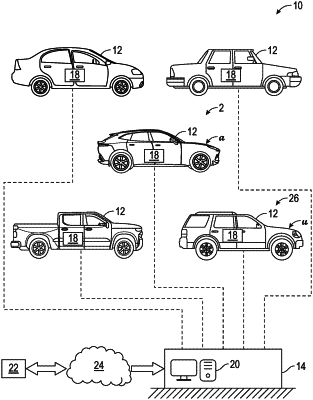| CPC B60W 40/068 (2013.01) [B60T 8/1763 (2013.01); B60W 10/18 (2013.01); B60W 40/13 (2013.01); H04W 4/46 (2018.02); B60W 2552/40 (2020.02); B60W 2555/20 (2020.02); B60W 2556/10 (2020.02); B60W 2556/65 (2020.02)] | 20 Claims |

|
1. A distributed computing system for determining road surface traction capacity for roadways located in a common spatio-temporal zone, the distributed computing system comprising:
a plurality of vehicles that each include a plurality of sensors and systems that collect and analyze a plurality of parameters related to road surface conditions in the common spatio-temporal zone, wherein the plurality of parameters include a traction level for a selected vehicle that represents an ego vehicle, and wherein the plurality of sensors and systems produce a response indicating a condition indicative of the road surface traction capacity for the common spatio-temporal zone and the response is a high excitation context, a low excitation context, or both; and
one or more central computers in wireless communication with each of the plurality of vehicles, wherein the one or more central computers execute instructions to:
determine at least one of a perfect match value and a partial match value between two contextual data points between two discrete vehicles that are part of the plurality of vehicles, where the two contextual data points are part of the plurality of parameters; and
combine at least one of the perfect match value and the partial match value with the traction level corresponding to the selected vehicle to determine a road surface traction capacity value for the common spatio-temporal zone.
|